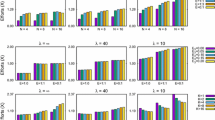Abstract
We sketch here the basis of a behavioral theory of non-market decision making or collective action. Departing from the basic social problem, the coordination of individual actions when individual rationality is opposed to collective rationality, we model a population of agents choosing their level of individual cooperation. The social dilemma that emerges may be solved in a bounded rationality evolutionary context. We find that the efficiency embodied in the solutions is dependent on the type of learning individuals adopt. Additional returns to the individual from collective contributions and discounting the future play key roles in the determination of the solution. We conclude that the emergent properties of the social cooperation agree with the findings in the experimental literature: cooperation, although not optimal, is a fact, and institutional settings affect the outcomes in a significant way.
Similar content being viewed by others
References
Andreoni, J. (1988). Why free ride? Strategies and learning in public goods experiments. Journal of Public Economics, 37, 291-304.
Andreoni, J. (1995). Cooperation in public goods experiments: kindness or confusion? American Economic Review, 85, 891-904.
Başçi E. (1999). Learning by imitation. Journal of Economic Dynamics and Control, 23, 1569-1585.
Cason, T.N. and Khan, F.U. (1999). A laboratory study of voluntary public goods provision with imperfect monitoring and communication. Journal of Development Economics, 58, 533-552.
Conlisk, J. (1996). Why bounded rationality? Journal of Economic Literature, 34, 669-700.
Dawes, R.M. and Thaler, R.H. (1988). Anomalies: cooperation. Journal of Economic Perspectives, 2, 187-197.
Elliot, C.S., Hayward, D.M. and Canon, S. (1998). Institutional framing: some experimental evidence. Journal of Economic Behavior and Organization, 35, 455-464.
Hoffman, E., McCabe, K.A. and Smith, V. (1998). Behavioral foundations of reciprocity: experimental economics and evolutionary psychology. Economic Inquiry, 36, 335-352.
Keser, C. (1996). Voluntary contributions to a public good when partial contribution is a dominant strategy. Economic Letters, 50, 359-366.
Kirchkamp, O. (1999). Simultaneous evolution of learning rules and strategies. Journal of Economic Behavior and Organization, 40, 295-312.
Ledyard, J. (1995). Public goods: a survey of experimental research. In R. Kagel (ed.), The Handbook of Experimental Economics. Princeton University Press, Princeton.
Lettau, M. and Uhlig, H. (1999). Rules of thumb versus dinamic programming. American Economic Review, 89, 148-174.
Mailath, G. (1998). Do people play nash equilibrium? Lessons from evolutionary game theory. Journal of Economic Literature, 36, 1347-1374.
Miller, J. and Andreoni, J. (1991). Can evolutionary dynamics explain free-riding in experiments? Economic Letters, 36, 9-15.
Palfrey, T.R. and Prisbrey, J.E. (1996). Altruism, reputation and noise in linear public goods experiments. Journal of Public Economics, 61, 409-427.
Palfrey, T.R. and Prisbrey, J.E. (1997). Anomalous behavior in public goods experiments: how much and why? American Economic Review, 87, 829-846.
Riechmann, T. (1999). Learning and behavioral stability: an economic interpretation of genetic algorithms. Journal of Evolutionary Economics, 9, 225-242.
Sefton, M. and Steinberg, R. (1996). Reward structures in public good experiments. Journal of Public Economics, 61, 263-287.
Sonnemans, J., Schram, A., and Offerman, T. (1999). Strategic behavior in public good games: when partners drift apart. Economic Letters, 62, 35-41.
Vriend, N.J. (2000). An illustration of the essential difference between individual and social learning and its consequences for computational analysis. Journal of Economic Dynamics and Control, 24, 1-19.
Willinger, M. and Ziegelmeyer, A. (1999). Framing and cooperation in public good games: an experiment with an interior solution. Economic Letters, 65, 323-328.
Author information
Authors and Affiliations
Rights and permissions
About this article
Cite this article
Montoro-Pons, J.D., Garcia-Sobrecases, F. A Computational Approach to the Collective Action Problem: Assessment of Alternative Learning Rules. Computational Economics 21, 137–151 (2003). https://doi.org/10.1023/A:1022211603767
Issue Date:
DOI: https://doi.org/10.1023/A:1022211603767




